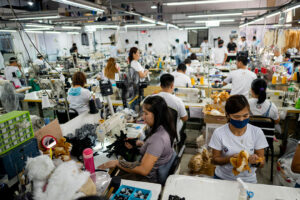Sustained growth to hinge on ‘prudent reopening’ of economy

THE Department of Finance (DoF) on Saturday called for continued support for the pandemic containment effort to ensure that the economy’s growth is sustained.
In an Economic Bulletin, the DoF said a “robust” vaccination effort must continue alongside a “prudent reopening of the economy to sustain economic momentum.”
“The country must continue to hedge against risks posed by coronavirus disease 2019 (COVID-19) through a robust vaccination program and prudent reopening of the economy to sustain recovery momentum,” the DoF said.
As of March 30, over 140 million COVID-19 doses have been administered, with an average of 105,000 doses administered daily, according to the Department of Health’s website.
Metro Manila and 48 other areas will remain under Alert Level 1, the most relaxed quarantine setting, between April 1 and 15.
The DoF said that the Retail Trade Liberalization Act, the Foreign Investments Act, and the Public Service Act will play a critical role in the economic recovery.
The recently amended Public Service Act now allows 100% foreign ownership in industries formerly classified as public utilities, including telecommunications, airports, and shipping.
Rizal Commercial Banking Corp. Chief Economist Michael L. Ricafort said in a text message that easing restrictions could cause the Purchasing Managers’ Index (PMI) to rise in the coming months as manufacturing revives.
“Local manufacturing activities could continue to recover in the coming months fundamentally due to additional measures to further reopen the economy, with the shift towards granular lockdowns and latest shift to Alert Level 1 in more areas around the country,” he said.
He added that as more industries open up, such as tourism and education, businesses that depend on such traffic will benefit, with the recovery eventually filtering down to manufacturing as well.
“Firms sustained hopes that COVID-19 will pose a lesser threat to the economy and demand will continue to pick up.” Maryam Baluch, economist at S&P Global said in their report on the Philippines PMI.
Philippine manufacturers remained positive about their output growth for the coming year, due to easing restrictions and higher demand, with some citing a “positive election outcome,” S&P Global said.
S&P Global Philippines, which merged with IHS Markit last month, reported that the S&P Global Philippines Manufacturing PMI improved to 53.2 in March, from 52.8 in February. This also matches the PMI reading in December 2018, the highest in over three years.
The PMI is a leading indicator based on surveys of purchasing managers, who help determine how much raw material to order for their companies, which in turn signals the level of expected manufacturing activity a few months into the future. The PMI is presented on a 50-point scale, with a reading above 50 suggesting that manufacturing activity is expected to increase. A reading below 50 signals a contraction.
Ms. Baluch said the easing of alert levels and mobility restrictions could be offset by geopolitical concerns, which are causing inflation to rise, mainly because of the fallout from the Russia-Ukraine war in the form of disrupted markets for oil, wheat, and fertilizer.
S&P Global said its survey data point to an increase in new orders and output in March. Demand for domestic goods was at its highest in over three years since 2019, and also matched the reading for February 2022.
Manufacturing companies’ output and new orders grew in March, S&P Global said, citing higher demand, which caused manufacturers to expand inventories and to sustain production.
However, inflation had an impact in March, “as supply and demand imbalances pushed up raw material prices,” S&P Global said, causing manufacturers to increase factory gate prices or lay off workers to reduce operating expenses.
Export orders declined after having registered an increase for the first time in seven months in February.
The Russian invasion of Ukraine, which began on Feb. 24, caused shipment delays and high fuel prices during the month, adding to pressure on supply chains.
“The war in Ukraine, COVID-19 cases rising in China, scarcity of materials and supply bottlenecks led to further worsening of supplier delivery times.” Ms. Baluch said. “Moreover, inflationary pressures reached record-highs as cost burdens and selling prices rose at faster paces.”
Employment levels continued to drop as a result of resignations and cost-cutting, she said. — Alyssa Nicole O. Tan




